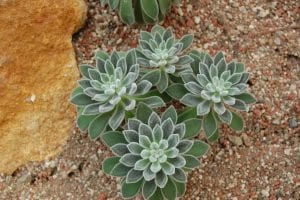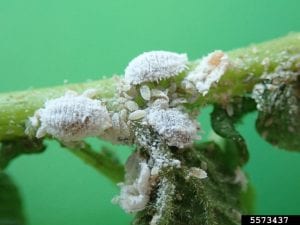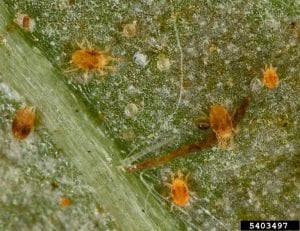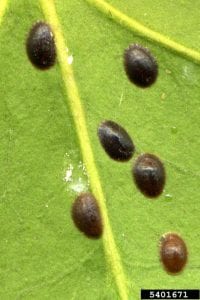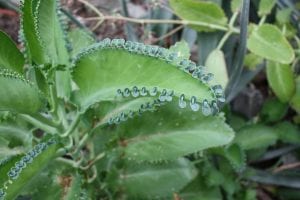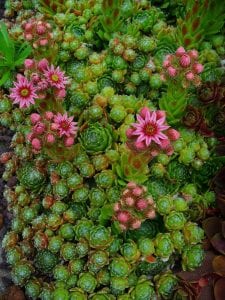Biting / Chewing vs. Piercing / Sucking
By Susan Ndiaye, Community Horticulture Educator
This article appeared in the July 2019 Issue of Gardening in Orange County. Click here to subscribe!
Insects can cause a lot of damage to your plants. Determining what insect is causing damage to your plant is key to developing an effective management strategy. The first step is to examine the damage.
Biting/Chewing Insects
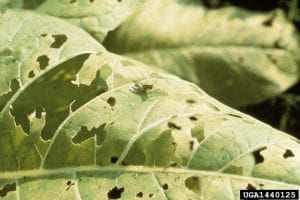
Biting/chewing insects create holes in plant leaves. The size and shape of these holes varies by insect. The three most common types of insects with biting/chewing mouthparts you may find in your garden are: grasshoppers, butterfly/moth larvae, and beetles (adults and larvae).
Grasshoppers

Grasshoppers are a sporadic pest and rarely cause substantial damage to garden plants. During dry years when other plants dry out, grasshoppers may seek refuge and food in your lush green garden. Unfortunately, because grasshoppers are highly mobile they are difficult to manage. If you have an ongoing problem with grasshoppers, you can reduce populations, by fall tillage as grasshoppers overwinter as eggs laid in the soil.
Imported Cabbageworm (Pieris rapae)


Those beautiful white butterflies you see fluttering around your garden, may seem innocuous, but their larvae, the imported cabbageworm, can cause extensive damage to plants in the brassica family also known as cole crops. These plants include broccoli, cabbage, Brussel sprouts, collards, kale, radishes, and turnips. The caterpillar is bright green with a yellow stripe down the center of its back. They start out chewing little holes in the leaves of the plants, but eventually consume the entire leaf leaving only the midrib behind.
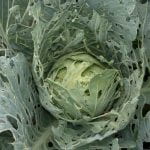
To monitor for these pests, look for dark green frass or poop near feeding areas. Once you discover a population of imported cabbageworm, depending on how numerous they are you can hand pick them off your plant. The use of Bt (Bacillus thuringensis), a microbial insecticide is also highly effective on younger caterpillars. This particular pest spends the winter in the pupal stage, so to prevent future infestations you can eliminate overwintering sites in your garden by removing plant debris.
Stripped and Spotted Cucumber Beetles (Acalymma vittatum and Diabrotica undecimpunctata howardi)

Although they are called cucumber beetles, these insects feed on much more than cucumbers. The stripped cucumber beetle prefers plants in the cucurbit family (squash, pumpkins, melons, etc.) feeding on leaves, flowers, stems and fruits. They can be especially detrimental to young seedlings.

The spotted cucumber beetle is more of a generalist and feeds on cucurbits as well as beans, tomatoes, and ornamentals. The larvae of this beetle can do substantial damage on the roots of corn plants hence its other name, the southern corn rootworm.

Cucumber beetles vector or transmit bacterial wilt (Erwinia tracheiphila), a common disease in cucurbits in which bacteria clog up the vascular system of the plant preventing the flow of water and causing the plant to wilt and eventually die.
One way to protect your plants from cucumber beetles is by using row cover. This can be put on at planting and kept on until female flowers appear, then it must be removed to allow for pollination.
Sucking/Piercing Insects

Sucking/piercing insects can cause of variety of symptoms including leaf malformation and leaf discoloration. The most common types of insects with sucking/piercing mouthparts are from the Order Hemiptera, also known as the “true bugs”. This order of insects contains, stink bugs, squash bugs, cicadas, leaf hoppers, scale, aphids and many more.
Brown marmorated stink bug (Halyomorpha halys)

Many people are familiar with this invasive species because the adults invade their home every fall looking for a nice warm place to spend the winter. Although it can be an unwelcome house guest it also can cause major damage on fruits and vegetables. Some of the brown marmorated stink bug’s favorite snacks include apples, peppers, beans, tomatoes, and sweet corn.

Controlling the brown marmorated stink bug can be quite difficult because they are highly mobile, feed on a large variety of plants, and adults are highly resistant to insecticides. Monitoring for these pests is the best way to start. Bunches of about 28 eggs are laid on the underside of leaves and should be removed and destroyed if found. When the eggs hatch the 1st instar nymphs cluster around the egg mass making them an easy target for removal. The bugs usually drop down when startled, so for hand removal, you can knock them into a container of soapy water.
Lots of research is being done to develop effective management strategies for brown marmorated stink bug. One of the most promising avenues of research is on biological control. A stingerless wasp known as the Samurai Wasp (Trissolcus japonicas) destroys 60-90% of brown marmorated stink bug egg masses in its native range in Asia. This tiny wasp has found its way to the United States and as of 2018 has been found in twelve states, including New York. Research is now being done to determine the effectiveness of rearing and releasing this tiny parasitoid. Check out this video about brown marmorated stink bug and the samurai wasp.
Potato Leafhopper (Empoasca fabae)


Despite their name, potato leaf hoppers feed on over 200 hundred different kinds of plants including potatoes, snap beans, cucumbers, pumpkins, egg plants, rhubarb, squash and sweet potatoes. The nymphs are neon green and are usually found crawling around on the underside of leaves. The adults only reach ⅛ inch in length. They are pale green and wedge shaped and fly away when disturbed.

These little pests do not overwinter in our area, but instead overwinter down south and the adults are brought up each year by the winds arriving in late-May / early-June. Although small, a few individuals can cause hopper burn on your plants. Hopper burn reduces yield and is characterized by chlorosis, or yellowing, of the leaf edges. Eventually these leaves begin to curl and turn brown.
It is easiest to combat these pest as flightless nymphs using insecticidal soaps or horticultural oils on the undersides of leaves. Dusting plants with diatomaceous earth can also help deter these pesky bugs.
Squash Bug (Anasa tristis)

Squash bugs are pests of all cucurbits, but prefer squash (summer and winter varieties) and pumpkins. Adults are a little over a ½ inch long and are dark brownish while nymphs are black, pale green or gray with black legs. These insects feed mainly on the leaves and the stems of squash plants, but can also feed on the fruits. Initially they cause a stippling on the leaves, but after heavy feeding the leaves begin to look tattered.

Squash bugs overwinter as adults, so at the end of the season cleaning up plant debris and mulch will remove overwintering sites. Eggs are bronze colored and usually laid in clumps on the underside of leaves. Removing and destroying egg masses can help keep squash bug numbers down. Adults and nymphs are known to hide in mulch around the base of the plants, laying down a board or piece of cardboard will provide a hiding place for these bugs. You can then remove the shelter and destroy all the bugs underneath it. There are also some cultivars of both summer and winter squash that are resistant to squash bugs.
Of course there are lots of non-insect pests that can wreak havoc on your garden as well and whose damage can sometimes be confused with insect damage. Snails and slugs have rasping mouth parts that create holes in plant leaves much like insects that have biting/chewing mouth parts. Spider mites having piercing/sucking mouth parts that cause stippling on plant leaves like the “true bugs”.
So as you try to determine what is causing damage to your plants keep in mind that different kinds of insects cause different kinds of damage and that determining the cause is essential to developing a solution.
Note: Pesticide recommendations are not a substitute for pesticide labeling. Remember to read the label before applying any pesticide. The label is the law!
Helpful References
Vegetable Problems Caused by Insects
https://extension.umd.edu/resources/yard-garden/vegetables/vegetable-problems-caused-insects
Brown Marmorated Stink Bug
https://www.stopbmsb.org/stopBMSB/assets/File/BMSB-in-Vegetables-English.pdf
https://extension.umd.edu/resource/stink-bugs-vegetables-and-fruits
Grasshoppers
https://extension.tennessee.edu/publications/Documents/sp290-x.pdf
Imported Cabbageworm
https://extension.umd.edu/resource/imported-cabbageworm-vegetables
http://idl.entomology.cornell.edu/wp-content/uploads/Imported-Cabbageworm.pdf
Potato Leafhoppers
https://extension.umd.edu/resource/potato-leafhopper-vegetables
Squash Bugs
https://extension.umd.edu/resource/squash-bug-vegetables
Striped and Spotted Cucumber Beetles
https://extension.umd.edu/resource/cucumber-beetles-spotted-or-striped-vegetables

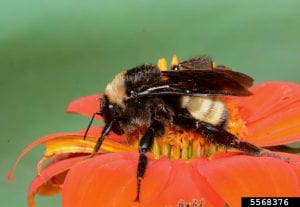
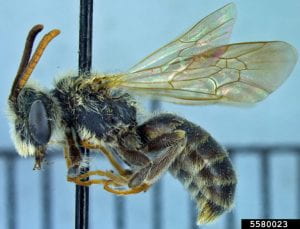

![stanze from Germany, Baden-Württemberg [CC BY-SA 2.0 (https://creativecommons.org/licenses/by-sa/2.0)] Mason bee on board with](https://blogs.cornell.edu/master-gardeners-cce-oc/files/2019/04/Mason_bee_apartment_building-ugwjwf-300x275.jpg)

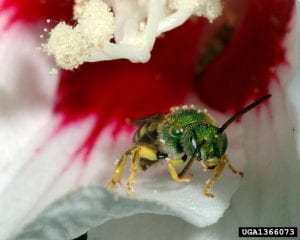






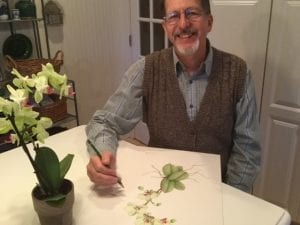




![Photo by (c) 2006 Derek Ramsey (Ram-Man). Co-attribution - Chanticleer Garden. [CC BY-SA 3.0 (http://creativecommons.org/licenses/by-sa/3.0/)], from Wikimedia Commons Aeonium arboreum 'Zwartkopf'](https://blogs.cornell.edu/master-gardeners-cce-oc/files/2019/01/Aeonium-arboreum-Zwartkopf-1k523kl-300x254.jpg)
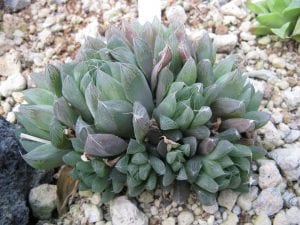
![Frank Vincentz [GFDL (http://www.gnu.org/copyleft/fdl.html) or CC-BY-SA-3.0 (http://creativecommons.org/licenses/by-sa/3.0/)], from Wikimedia Commons](https://blogs.cornell.edu/master-gardeners-cce-oc/files/2019/01/Kalanchoe_eriophylla_02_ies-25v976e-300x263.jpg)
![Emmanuelm at English Wikipedia [CC BY 3.0 (https://creativecommons.org/licenses/by/3.0)]](https://blogs.cornell.edu/master-gardeners-cce-oc/files/2019/01/Crassula_bonsai-22f5pwe-256x300.jpg)
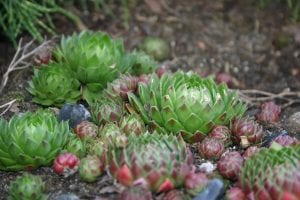
![Daderot [Public domain], from Wikimedia Commons Sedum ruspestre 'Angelina'](https://blogs.cornell.edu/master-gardeners-cce-oc/files/2019/01/Sedum-rupestre-Angelina-on-a-rock-wall-slwnzo-e1547837668654-300x260.jpg)
